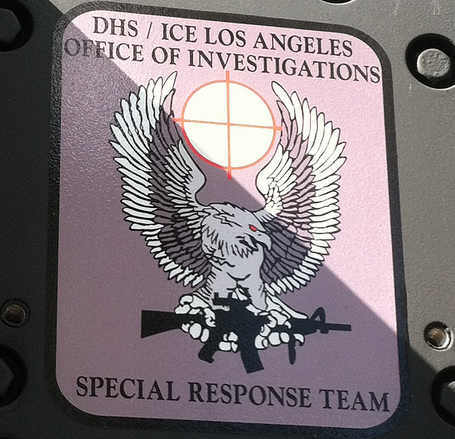
“If you don’t have enough evidence to charge someone criminally but you think he’s illegal, we can make him disappear.”
Those chilling words were spoken by James Pendergraph, then executive director of Immigration and Customs Enforcement’s (ICE) Office of State and Local Coordination, at a conference of police and sheriffs in August 2008.
Also present was Amnesty International’s Sarnata Reynolds, who wrote about the incident in the 2009 report “Jailed Without Justice” and said in an interview, “It was almost surreal being there, particularly being someone from an organization that has worked on disappearances for decades in other countries. I couldn’t believe he would say it so boldly, as though it weren’t anything wrong.”
ICE agents regularly impersonate civilians–OSHA inspectors, insurance agents, religious workers–in order to arrest longtime US residents who have no criminal history. Jacqueline Stevens has reported a web-exclusive companion piece on ICE agents’ ruse operations.
Pendergraph knew that ICE could disappear people, because he knew that in addition to the publicly listed field offices and detention sites, ICE is also confining people in 186 unlisted and unmarked subfield offices, many in suburban office parks or commercial spaces revealing no information about their ICE tenants–nary a sign, a marked car or even a US flag. (Presumably there is a flag at the Veterans Affairs Complex in Castle Point, New York, but no one would associate it with the Criminal Alien Program ICE is running out of Building 7.) Designed for confining individuals in transit, with no beds or showers, subfield offices are not subject to ICE Detention Standards. The subfield office network was mentioned in an October report by Dora Schriro, then special adviser to Janet Napolitano, secretary of Homeland Security, but no locations were provided.
Read moreAmerica’s Secret ICE Detention Castles: Jailed Without Justice




 filed Thursday on behalf of 10 ICE agents against the head of the Department of Homeland Security, Janet Napolitano, and ICE Director John Morton asks the courts to overturn the June 15 directive by Obama to suspend deportation proceedings and offer work authorization to some immigrants brought here illegally as children.
filed Thursday on behalf of 10 ICE agents against the head of the Department of Homeland Security, Janet Napolitano, and ICE Director John Morton asks the courts to overturn the June 15 directive by Obama to suspend deportation proceedings and offer work authorization to some immigrants brought here illegally as children.






